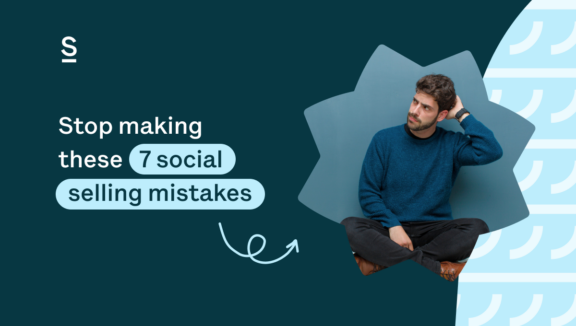Stop making these social selling mistakes

Stop making these 7 social selling mistakes
With the social selling trend quickly accelerating, more and more people are jumping on the bandwagon. However, if you’re new to the strategy or you’re not treating it seriously, chances are you’re making a lot of mistakes that are sabotaging your results. It may be tempting to dive right in and start messaging people on LinkedIn, but let’s break down 7 mistakes that are stopping you from maximising your social selling efforts…
1. Not doing enough research on your ideal prospects
With social selling, it can be tempting to start contacting each and every person on Linkedin in an attempt to sell your product or service to them. If you feel the urge to cover a very broad spectrum of prospects, take a step back and think about your ideal customer for a minute.
Narrowing your scope to your target audience will help you focus on those who are most likely in need of your offerings and solutions, meaning they will be more likely to convert. Once you have that outlined, consider doing more research about your prospects: find out what their occupation is, what position they hold at a company and if they are decision makers. This will help you adjust your communication style and give you firmer ground for a more solid connection.
But don’t stop there – investigate the pain points of your prospects and the problems they are lacking the solutions to. Try to understand the journey of each person you want to reach out to to maximise the chances of securing a deal. Conducting all of this research prior to even initiating a connection with a prospect will provide you with insight towards how you can help them solve their pain.
Another tip would be to produce content based on what you’ve learned about your contacts – serve some valuable insights and educate yourself about their problems so that you can suggest solutions accordingly.
2. Moving forward with no solid foundation
Just like venturing out on a tough hike with no preparation or gear, kick-starting social selling without setting up your playing field will not likely end well… Consider starting with optimising your LinkedIn profile for social selling.
If your LinkedIn page is not adapted for sales, chances are your prospects won’t take you seriously. Begin with building a personal brand and showcasing your expertise. Start posting valuable content and communicate your willingness to help prospects solve their pains. Remember, that social selling is based on trust, reputation, sympathy and engagement with your ideal target audience in mind.
3. Doing the Sales Pitch way too early
We’ve briefly touched on the trust factor, but it’s hard to overemphasize. If you fail to establish a trustworthy relationship with a prospect before you shoot them with your sales pitch, it’s highly likely you’ll scare them off.
When social selling, try to engage with your contacts and find common ground before asking them to commit to a demo call or a product trial. Discuss their issues, drop some tips and show that you do have the means to help them out.
This way, not only will your leads get warmer and warmer, but they’ll also be more likely to convert when you ask for it.

4. Talking about yourself
Have you reached out to someone beginning with “Hi, my name is X from Y company and I…”? Try to recall how long it took to hear back from that person, if ever. When you reach out to a prospect and start talking about yourself straight away, you risk coming across as one of the spammers who are just so desperate to sell what they’re offering.
Instead, talk about your prospect! Make use of your research and engage with them on their recent activity or point of interest. If you know the person might benefit from your service or product, start with a conversation about the roadblocks they may be facing – prove you and your offering are worthy of their time. People will be more likely to respond and will most probably want to talk about themselves to someone who is willing to listen.
5. Sending generic messages
If there is one thing you take away from this article, let it be this. Stop sending away generic sales messages. Seriously.
Here’s why the 1-size-fits-all message no longer works:
1. People are not dumb – they notice it. Social media users are becoming extremely aware of businesses entering the field and trying to trap them into buying their products with ads and DM’s. When you’re sending something generic, it becomes clear to the user that there’s no point in even reading the message till the end.
2. You may come off as a robot, which is the last thing you want, as you instantly lose all your credibility, even if your account and content are perfect. And by the way, if you’re using automation for theme messages, LinkedIn may recognize it and ban your account altogether.
3. It’s simply annoying, and frankly – spam.
So how do you fix this? Personalization will be your best friend. Once again, utilize what you’ve learned about your prospect. Greet them by their name and open with a sentence that shows you know who they are or what they’ve been up to. Maybe you’ve seen them share something, comment on a post, or follow someone you also know.
6. Not boosting your activity with useful tools and software
Regardless of how deeply you are engaged in social selling, you have to be taking notes of your activity somewhere. An old school notebook might do the job at the beginning, but we suggest that you at least create a simple spreadsheet with your prospects information. Record their contact details, company, position and the stage of negotiation you’re at. It won’t hurt to have a separate column to schedule any further activities.
If you feel like your scope of activity is outgrowing the spreadsheet, invest in a CRM such as HubSpot, Salesforce, Pipedrive, or Copper – depending on your needs. This way you will have all your data organized and it will also be easier to track the stages of each deal in your pipeline.
Although automation tools are prohibited by LinkedIn, there are plenty of extensions that take off the heavy load of manual work for you, like Surfe (ex-Leadjet), for example. This chrome extension integrates your CRM with LinkedIn, making it easier to add contact information and track deals in the pipeline.
Sign up for your free 14-day trial or book a demo to learn more about what Surfe (ex-Leadjet) has to offer.
7. Ditching spontaneity
Social selling is a strategy. This means that winging it is not a good idea. If you take random actions, you risk wasting time and getting nothing in return.
Instead, try to come up with a plan of execution, map out the stages of the sales process and set up a framework for yourself. Remember that only consistent actions will deliver consistent results.
Bottom Line
Implementing new trends can be intimidating and overwhelming, but they are definitely worth trying out – you never know how your business might benefit from the slightest tweaks.
But since making mistakes is part of the journey, make sure you learn from them and perfect your strategy via trial and error. Everyone’s sales flow is different, so you’ll need to figure out what works best for you. Don’t hesitate to take a look to our article about social selling on LinkedIn!
Social selling won’t work unless you do.


